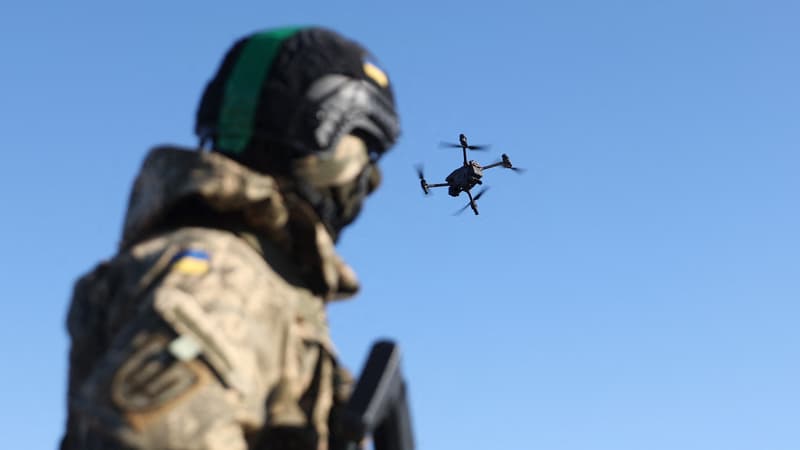A few hours after the incursion of around twenty Russian drones into Polish airspace in September, European Commission President Ursula von der Leyen declared that it was time for Europe to build an “anti-drone wall” to protect its eastern flank.
Drone incidents detected over airports in Denmark and Germany in the following weeks reinforced the view among European leaders that the continent urgently needed to better protect itself against the threat.
However, the “anti-drone wall” project remains uncertain.
Southern and Western European countries are not convinced
Andrius Kubilius also told Reuters that the EU should rely heavily on Ukrainian experience, gained over almost four years, to counter waves of Russian drones. The “anti-drone wall” project is a test of the EU’s defense ambitions, an area traditionally reserved for member states and NATO, as well as its ability to better guarantee its own security, as demanded by US President Donald Trump.
The Commission, the EU’s executive body, is working to convince governments in southern and western Europe, which have argued that the original plan was too focused
on the bloc’s eastern border, while drones could represent a threat to the entire continent. The proposal is also the subject of a power struggle for control of major European defense projects, which Germany and France are reluctant to hand over to the Commission, diplomats say.
Some European officials have also questioned the term “anti-drone wall,” saying it carries a false promise of security when no system will be able to repel all devices. To ensure greater support, the Commission expanded the initial concept of an integrated network of sensors, jamming systems and weapons along the EU’s eastern border to a continental organization of anti-drone systems.
“A road full of traps”
He plans to change the name of his project to evoke a “European Initiative for Defense against Drones” in a “roadmap” to be presented on Thursday. If it comes to fruition, the project will be a boon for manufacturers of anti-drone systems, from startups in the Baltic countries to big defense industry players such as German companies Helsing and Rheinmetall.
The Commission did not say how much its project would cost. It could generate billions of euros in orders, but will struggle to secure EU funding without massive support from European governments, according to geopolitical consultancy Rane.
Should Europe take inspiration from Ukraine?
The project evolved into a more defense-focused concept after Ukrainian Deputy Prime Minister Mykhailo Fedorov presented to Ursula von der Leyen in April how kyiv is combating Russian drone attacks.
The Russian incursion into Polish airspace on September 9 further highlighted the lack of preparedness of EU countries for the drone threat, increasing the sense of urgency. On this occasion, NATO deployed F-35 and F-16 fighter jets, helicopters and a Patriot air defense system worth a total of several billion dollars to counter the Russian Gerbera drones – based on the Iranian Shahed models – which are infinitely cheaper.
Once the Commission has developed its project, Member States will decide whether to give it the green light or not. According to diplomats, if small countries consider it more useful for the Commission to coordinate these types of projects, some large states, such as France and Germany, want to maintain control. Neither German Chancellor Friedrich Merz nor French President Emmanuel Macron have so far signed the EU executive’s proposal. At an EU summit in Copenhagen earlier this month, Emmanuel Macron declared that threats linked to drones were “more sophisticated, more complex” than the idea of a “wall” intended to protect against them suggested.
Machine guns, cannons, missiles, interception drones, electronic jamming systems and lasers.
Taking lessons from the Ukrainian experience, the project should include cameras, acoustic systems, radars and radio frequency detectors, according to the
Guidance provided by more than a dozen European officials and industry executives. “We need to have a multi-level system that can detect, classify, attack and eliminate the target,” said Leet Rauno Lember, CEO of Estonian company Marduk Technologies.
Weapons to counter the attacks would include machine guns and cannons, rockets, missiles and interceptor drones, as well as electronic jamming systems and lasers, the sources interviewed by Reuters also said.
Artificial intelligence is already used to identify and target drones and its use in this area should increase, according to manufacturers. “There is no one-size-fits-all solution. There is no magic technology,” said Dominic Surano, director of special projects at Nordic Air Defense, a Stockholm-based company that has developed a mobile interception system. Experts further point out that the project would require constant updates as drones are evolving rapidly.
The EU and its member states will need to determine which systems to buy, where to use them and how to link them, bloc officials and industry executives said. Any device will also have to integrate with NATO’s broader air and missile defense systems, according to experts, some of whom believe the Commission’s project could take years to come to fruition.
Source: BFM TV


